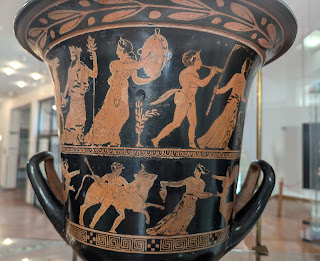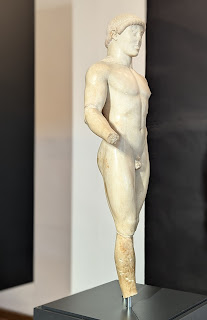At the heart of the museum was one of the richest and most prestigious pottery collections that had been complemented by donations from other collections and the most recent excavations. All the exhibits of works by Attic potters were brought to light during excavations in Agrigento's necropoli and attest to the city's inhabitants' high standard of living.
Particularly interesting were the kraters or craters, a large two-handled vase found in ancient Greek pottery and metalwork. These were mostly used for mixing wine with water. The first craters depicted animal fights, but at the beginning of the 6th century BC, a new painting technique was introduced. The backgrounds were painted black, and the figures were made of red-brown clay with details in diluted black paint, which allowed the artist greater freedom in drawing.
The Red Figure Bell Crater, attributable to the painter Kleophon, dates to 420 BC and was found in 1962 in Agrigento's urban area, which was used between the end of the fifth and the first decades of the fourth century BC. The crater shows a sacrifice at Delphi's Sanctuary of Apollo with members of the sacrificial procession: a flute player and one who pushed the goat toward the center, where the sacrifice was being prepared. Another crater by Kleophon is displayed in a Boston museum.
Another glorious Attic Red Figure Crater was attributed to the painter Lugano and dates to the 5th century BC.
The large plate was produced at Paestum circa 330 BC.
The 330-320 BC Bell Crater in Red Figure portrays Hercules wearing a crown and sitting on a rock covered by lion skin. Behind him, a man plays the flute while a young woman in front holds a large plate of offerings.
Considered one of the most beautiful pieces in the museum's vase collection was this Large Calyx Crater from 500-490 BC. It was unearthed in Agrigento's necropolis in 1940. The artist depicted funeral games with six individuals represented in various positions. The other side represented the burial or transport of a fallen warrior, likely Patroklos, covered in a richly adorned mantle and lifted by two fully armed companions. I read that the scene recalls verses in Homer's Iliad which describe the rite of washing the body of a fallen warrior.
The Calyx Crater Red Figure from 470-460 BC was attributed to the Agrigento painter, who was named for the vessel. It shows the struggle between Hercules and the centaur Nessus.
The other side showed the departure scene of young soldiers wearing mantles who faced each other in pairs.
Another room displayed architectural sculptures from the end of the 6th century BC, including spouts shaped like lion heads to ward off ill luck.
The unusual modeled vessel is decorated with a red figure in the form of a mule with a raised penis, dated to about 500 BC. On its back was a wine cup instead of a rider. Beneath the mule's belly was a satyr kneeling between the legs.
Terracotta molds, produced by ancient craftsmen to make statuettes, masks, and reliefs, were found along the city wall, where kilns were located.
Votive materials included archaic female busts and statuettes of divinities from the second half of the 6th century and the first years of the 5th century BC.
The terracotta statuette of Aphrodite showed her squatting as she wrung her hair with both hands.
The terracotta bust of a female divinity, possibly Persephone, was dated to the beginning of the 5th century because of its youthful lines. I couldn't help but marvel at the delicate modeling of the face and hair set in complicated waves that looked like a crown. The figure had many traces of the original plaster surfacing, which served as the base for painted colors.
Kouros, The Agrigento Youth: An unknown sculptor made this figure of a nude youth - a statue type known as a kouros - around 480 BC. This period represented the change in artistic style between the Archaic and Classical periods, with rigid poses and serene expressions giving way to more naturalistic poses. Though the marble was imported from Greece, the prominent cheekbones, heavy-lidded eyes, and well-defined lower lip identified it as being crafted by a Sicilian. It was unearthed in Akragas, now known as Agrigento.
One of the museum's masterpieces, Statue of a Young Soldier, was on loan from the J. Paul Getty Museum in Los Angeles. The marble figure of a naked young soldier dates to 480 BC and was discovered in 1897 in a cistern near the Temple of Demeter on the Rupe Atenea.
The small, white marble statue of a crouching Aphrodite bathing dates to the first centuries BC. It was created by the sculptor Diodalsas.
The Marble Statue of Draped Figures shows men wearing the official dress of magistrates or members of the emperor's family.
In 1885, a serendipitous discovery was made in Agrigento's Montelusa necropolis of a Greek marble sarcophagus from the 5th century BC that resembled a Doric temple.
Another fortuitous discovery was made in 1975 with the finding of hundreds of fragments that became a marble sarcophagus of a child with decorations on three sides. The scenes on one side included the moments immediately after the child's birth. On another side, two figures assisted the child to the kingdom of death, as portrayed by a small chariot pulling a sheep. The very realistic sarcophagus was fashioned in a Roman workshop during the 2nd century BC.
It was sad that the museum was almost empty, as its excellent collections deserved far more visitors, in my opinion. I guess the low number explained why we saw no guards.
The little Tomb of Theron was located on the plain outside the southern city wall, well away from the Hill of Temples. The Greek-Roman cemetery of Agrigento was one of the oldest funerary monuments.
En route to the valley below the temples:
From the valley, we had a final gorgeous view of the Temple of Juno Lacinia, where we had started our temple tour earlier in the day.
Next post: The intriguing Scala dei Turchi and exploring Sciacca.
Posted on Steven's birthday, January 18th, 2025, from chilly Denver as we're in the middle of an Arctic vortex. If you are in the path of this extreme cold front, stay warm and drink lots of hot tea! Take care of yourself and your loved ones.





































Fascinating, thank you so much.
ReplyDeleteGlad you enjoyed seeing the marvelous treasures in the museum. They were a fantastic complement to the Valley of the Temples.
ReplyDeleteYes, I agree that the "Regional Archaeological Museum" is awesome. JDK
ReplyDeleteI remain amazed how such stunning artifacts stood the test of time, Janina.
ReplyDelete